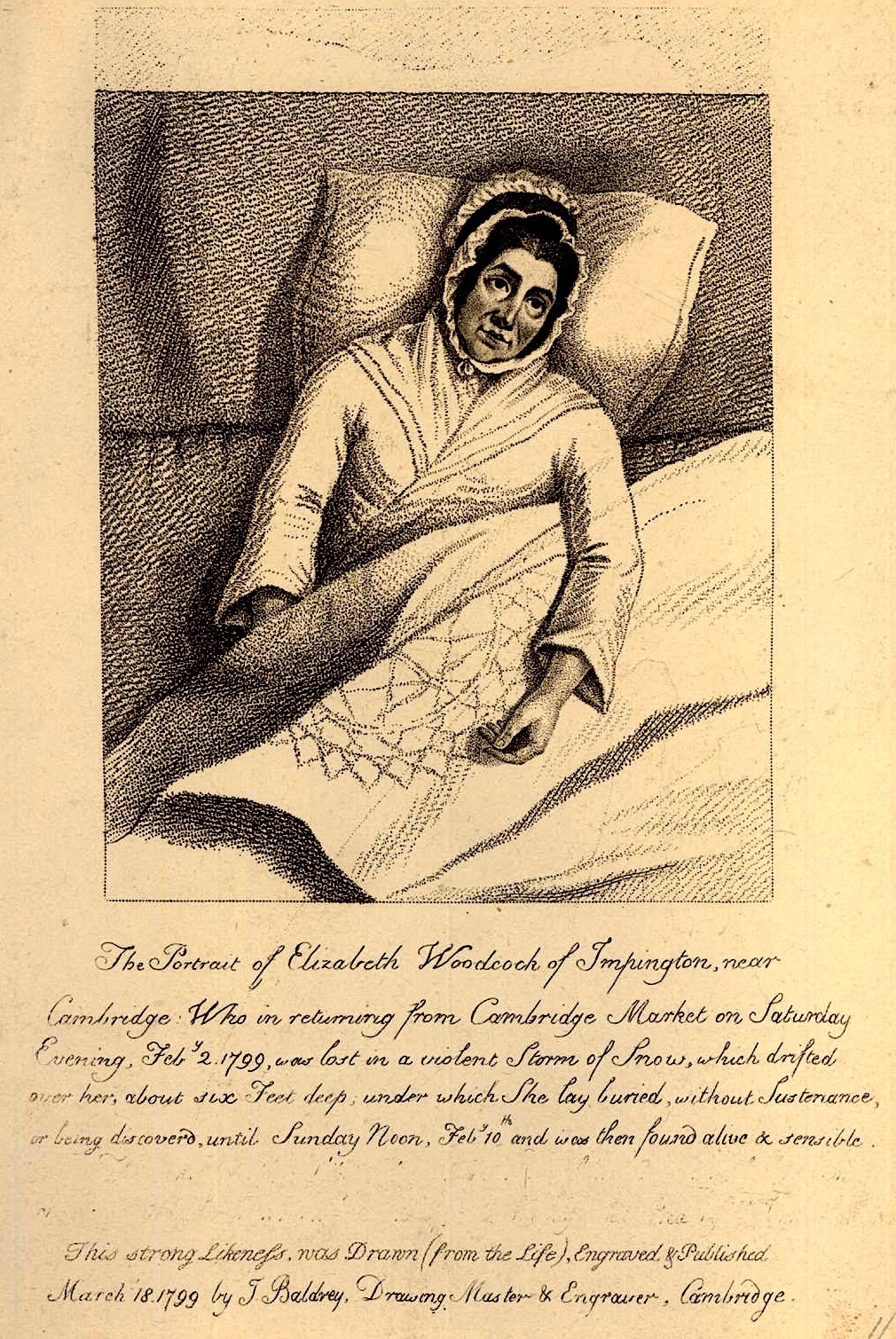Background
Born in 1756 at Impington, Elizabeth Williams married John Sockling in 1785. They had five children. John died in 1794. In 1796 Elizabeth married Daniel Woodcock, a local farmer. Shortly after they had a son.
It was common practice for villagers to attend the market in Cambridge. No different for Elizabeth, she had eggs and butter to sell. On Saturday 2 February 1799 she set off on the five mile trip to Cambridge astride her horse, Tinker. That year was one of the coldest on record with several weeks of severe frost. Snow fell as Elizabeth set off. On her return she carried coal, her basket was full of meat, candles and other items bought at the market. Aged 42 years, Elizabeth was of slender build.
She stopped off at The Three Tuns on Castle Hill, Cambridge. Heavy snow fell and Elizabeth filled her flask with brandy ready for a difficult trip home.
Elizabeth's ordeal
Half a mile from home Tinker took fright at about 7.00pm. As the horse headed back towards a ditch Elizabeth dismounted, aiming to lead him to safety. Tinker took fright again, got away from Elizabeth and headed across the common. By now Elizabeth was minus one shoe. She carried the heavy basket on her arm. Elizabeth recaptured Tinker when the horse encountered a hedge.
Fatigued and numbed with cold, Elizabeth sat down under a bush. She released the horse, saying 'Tinker, I am too much tired to go any further, you must go home without me. Lord have mercy. What will become of me?"
Elizabeth snuggled under the hedge in pitch darkness. By 8.00pm a six-foot snowdrift enveloped her. Elizabeth's clothes stiffened with frost. She settled down, awaiting the dawn.
The following day Elizabeth heard one of the village church bells ring. A hole opened in the snowdrift. Breaking a stick from a bush, she tied her handkerchief to it and poked this through the top of the snowdrift.
Tinker's return without Elizabeth caused alarm. Her husband and a friend immediately traced her route back to The Three Tuns in Cambridge. Villagers continued to search for the following four days. Suspicion fell on a camp of gipsies. Elizabeth's friends suspected robbery and murder. Despite two searches of the gipsy tents no evidence came to light. Elizabeth's husband resigned himself to finding her body when a thaw set in.
Elizabeth did hear people passing nearby during the following days. She was unable to attract their attention. Quenching her thirst by sucking on snow, pangs of hunger subsided after the first day. A thaw started on Friday 8 February. By Saturday the hole in the snowdrift enlarged. Elizabeth was weak, her clothes soaking wet and heavy. Unable to break through the snow, she doubted she could survive another day.
Rescue
Just past midday on Sunday 10 February a young farmer, Joseph Muncey, crossed an open field on his way home from Cambridge. He spotted Elizabeth's handkerchief. Approaching the snowdrift he heard laboured breathing. Through the hole in the snowdrift he recognised Elizabeth.
Joseph enlisted the help of a nearby farmer and shepherd. The latter called out 'Are you there Elizabeth Woodcock?' Elizabeth replied 'Dear John Stittle, I know your voice. For God's sake get me out of this place'.
Elizabeth's husband and neighbours brought a horse and cart. Wrapped in blankets, she returned home. Elizabeth had survived eight days in the snowdrift.
Recovery
Mr Okes, a Cambridge surgeon, was an acquaintance of the family. He attended Elizabeth as she travelled home in the cart.
Elizabeth suffered severe frostbite in her feet and legs. A fever arose in the days after her rescue. By the end of March Mr Okes amputated her toes. Although on the mend by mid-April, Elizabeth's spirits were low. She still had months to endure before new skin formed on the soles of her feet. Thereafter confined to crutches for the rest of her life, how was she to tend her young family?
Thomas Okes published a detailed report on the event and the cure he employed. It sold for one shilling (today £9). Proceeds went to Elizabeth and her family.
Death
In July 1799 Elizabeth fell ill and died shortly after. Her burial was on 14 July 1799. Details of the cause are sketchy.
William Robinson wrote to the local newspaper in 1939. He mentioned a handwritten note added to Elizabeth's entry in the church register. The note stated 'she was in a state of intoxication when she was lost and her death was accelerated (to say the least) by spirituous liquors afterwards taken - procured by the donations of numerous visitors.'
William was born and bred in Impington. Aged 54 years, he was foreman at a food processing firm. It's likely the report is true. William would not comment falsely when neighbours could easily check.
We're left with a puzzle why someone would add such a comment to the church register. Mr Okes gave a detailed account of Elizabeth's treatment. A regular visitor, he never mentioned any problem of alcohol. No other account of Elizabeth's ordeal mentioned alcohol as a cause of death.
Monument
Impington residents erected a stone monument at the location of Elizabeth's ordeal. A new memorial replaced the weathered original in 1849. The old version is part of the Museum of Cambridge collection.
The 1849 monument moved to its current location during construction of the St Ives to Cambridge railway.
Further reading
The 1799 items below use a long s. So 'missing since' is printed as 'miffing fince'.
1799 Elizabeth missing 9 February
1799 Elizabeth found 16 February
1799 Progress report 23 February
1799 Thomas Okes' report
1799 News of death 27 July
1939 Inebriation the cause of death?
Monument location on Google Maps





No comments:
Post a Comment